MITSUBISHI LANCER EVOLUTION 2007 Service Repair Manual
Manufacturer: MITSUBISHI, Model Year: 2007, Model line: LANCER EVOLUTION, Model: MITSUBISHI LANCER EVOLUTION 2007Pages: 1449, PDF Size: 56.82 MB
Page 1421 of 1449

HEATER, AIR CONDITIONER AND VENTILATION–On-vehicle Service HEATER, AIR CONDITIONER AND VENTILATION–On-vehicle Service55-19
8. Start the engine.
9. Operate the air conditioner and set at the lowest
temperature (MAX. COOL).
10. Fix the engine speed at 1,500 r/min.
11. Tighten the handle of the adaptor valve (valve open),
and replenish refrigerant while checking the quantity
through the sight glass.
Caution
If the service can is inverted, liquid refrigerant may
be draw into the compressor damaging it by liquid
compression. Keep the service can upright to ensure
that refrigerant is changed in gas state.
12. After replenishing is completed, turn the handle of the
adaptor valve all the way back (valve close), and remove
the quick joint.
NOTE
When there is remainder of refrigerant in the service can,
keep it for next use with the charge value and the valve
of the adaptor valve being closed.
DISCHARGING SYSTEM
Use the refrigerant recovery unit to discharge refrigerant gas
from the system.
NOTE : Refer to the Refrigerant Recovery and Recycling
Unit Instruction Manual for operation of the unit.
REFILLING OF OIL IN THE A/C SYSTEM
Too little oil will provide inadequate compressor lubrication
and cause a compressor failure. Too much oil will increase
discharge air temperature.
When a compressor is installed at the factory, it contains
130 cm
3of refrigerant oil. While the A/C system is in operation,
the oil is carried through the entire system by the refrigerant.
Some of this oil will be trapped and retained in various parts
of the system.
When the following system components are changed, it is
necessary to add oil to the system to replace the oil being
removed with the component.
Compressor oil: SUN PAG 56
Quantity
Condenser: 180 cm
3
Charging valve
Service can
(Refrigerant container)
Low-pressure
service valve
Page 1422 of 1449

HEATER, AIR CONDITIONER AND VENTILATION–On-vehicle Service HEATER, AIR CONDITIONER AND VENTILATION–On-vehicle Service55-20
PERFORMANCE TEST
1. The vehicles to be tested should be in a place that is
not in direct sunlight.
2. Close the high and low-pressure valve of the gauge
manifold.
3. Connect the charging hose (blue) to the low-pressure
valve and connect the charging hose (red) to the
high-pressure valve of the gauge manifold.
4. Install the quick joint (for low-pressure) to the charging
hose (blue), and connect the quick joint (for high-pressure)
to the charging hose (red).
5. Connect the quick joint (for low-pressure) to the
low-pressure service valve and connect the quick joint
(for high-pressure) to the high-pressure service valve.
NOTE
The high-pressure service valve is on liquid pipe A and the
low-pressure service valve is on the suction hose.
Caution
To connect the quick joint, press section “A” firmly
against the service valve until a click is heard.
When connecting, run your hand along the hose while
pressing to ensure that there are no bends in the
hose.
6. Start the engine.
7. Set the controls to the A/C as follows:
DA/C switch: A/C - ON position
DMode selection: Face position
DTemperature control: Max. cooling position
DAir selection: Recirculation position
DBlower switch: HI (Fast) position
8. Keep engine speed to idling speed with A/C clutch engaged.
9. Engine should be warmed up with doors and all windows
opened.
10. Insert a thermometer in the center A/C outlet and operate
the engine for 20 minutes.
11. Note the discharge air temperature.
NOTE
If the clutch cycles, take the reading before the clutch
disengages.
Performance Temperature Chart
Garage ambient temperature_C20253035
Discharge air temperature_C8-1112 - 1617 - 2122.5 - 27.5
Compressor high-pressure kPa740 - 840950 - 1,0501,160 - 1,3001,360 - 1,550
Compressor low-pressure kPa150 - 190190 - 240240 - 300300 - 375
Low-pressure valve
High-pressure valve
Gauge manifold
Charging
hose (red)
Charging
hose (blue)
Adaptor
valve (for low
pressure)Sleeve
Adaptor valve
(for high pressure)
Low-
pressure
service
valveHigh-
pressure
service
valveA
Thermometer
Page 1423 of 1449

HEATER, AIR CONDITIONER AND VENTILATION–On-vehicle Service55-21
REFRIGERANT LEAK REPAIR
LOST CHARGE
If the system has lost all charge due to a leak:
1. Evacuate the system. (See procedure.)
2. Charge the system with approximately one
pound of refrigerant.
3. Check for leaks.
4. Discharge the system.
5. Repair leaks.
6. Replace receiver drier.
Caution
Replacement filter-drier units must be
sealed while in storage. The drier used in
these units will saturate water quickly upon
exposure to the atmosphere. When
installing a drier, have all tools and supplies
ready for quick reassembly to avoid keeping
the system open any longer than necessary.
7. Evacuate and charge system.
LOW CHARGE
If the system has not lost all of its refrigerant charge;
locate and repair all leaks. If it is necessary to
increase the system pressure to find the leak
(because of an especially low charge) add
refrigerant. If it is possible to repair the leak without
discharging the refrigerant system, use the
procedure for correcting low refrigerant level.HANDLING TUBING AND FITTINGS
Kinks in the refrigerant tubing or sharp bends in
the refrigerant hose lines will greatly reduce the
capacity of the entire system. High pressures are
produced in the system when it is operating.
Extreme care must be exercised to make sure that
all connections are pressure tight. Dirt and moisture
can enter the system when it is opened for repair
or replacement of lines or components. The
following precautions must be observed. The
system must be completely discharged before
opening any fitting of connection in the refrigeration
system. Open fittings with caution even after the
system has been discharged. If any pressure is
noticed as a fitting is loosened, allow trapped
pressure to bleed off very slowly.
Never attempt to rebend formed lines to fit. Use
the correct line for the installation you are servicing.
A good rule for the flexible hose lines is keep the
radius of all bends at least 10 times the diameter
of the hose.
Sharper bends will reduce the flow of refrigerant.
The flexible hose lines should be routed so that
they are at least 80 mm from the exhaust manifold.
It is good practice to inspect all flexible hose lines
at least once a year to make sure they are in good
condition and properly routed.
Unified plumbing connections with O-rings, these
O-rings are not reusable.
COMPRESSOR NOISE
You must first know the conditions when the noise
occurs. These conditions are: weather, vehicle
speed, in gear or neutral, engine temperature or
any other special conditions.
Noises that develop during A/C operation can often
be misleading. For example: what sounds like a
failed front bearing or connecting rod, may be
caused by loose bolts, nuts, mounting brackets,
or a loose clutch assembly. Verify accessory drive
belt tension (power steering or alternator).
Improper accessory drive belt tension can cause
a misleading noise when the compressor is
engaged and little or no noise when the compressor
is disengaged.
Drive belts are speed-sensitive. That is, at different
engine speeds, and depending upon belt tension,
belts can develop unusual noises that are often
mistaken for mechanical problems within the
compressor.ADJUSTMENT
1. Select a quiet area for testing. Duplicate
conditions as much as possible. Switch
compressor on and off several times to clearly
identify compressor noise. To duplicate high
ambient conditions (high head pressure),
restrict air flow through condenser. Install
manifold gauge set to make sure discharge
pressure doesn’t exceed 2,070 kPa.
2. Tighten all compressor mounting bolts, clutch
mounting bolt, and compressor drive belt.
Check to assure clutch coil is tight (no rotation
or wobble).
3. Check refrigerant hoses for rubbing or
interference that can cause unusual noises.
4. Check refrigerant charge. (See “Charging
System”.)
5. Recheck compressor noise as in Step 1.
6. If noise still exists, loosen compressor mounting
bolts and retorque. Repeat Step 1.
7. If noise continues, replace compressor and
repeat Step 1.
Page 1424 of 1449
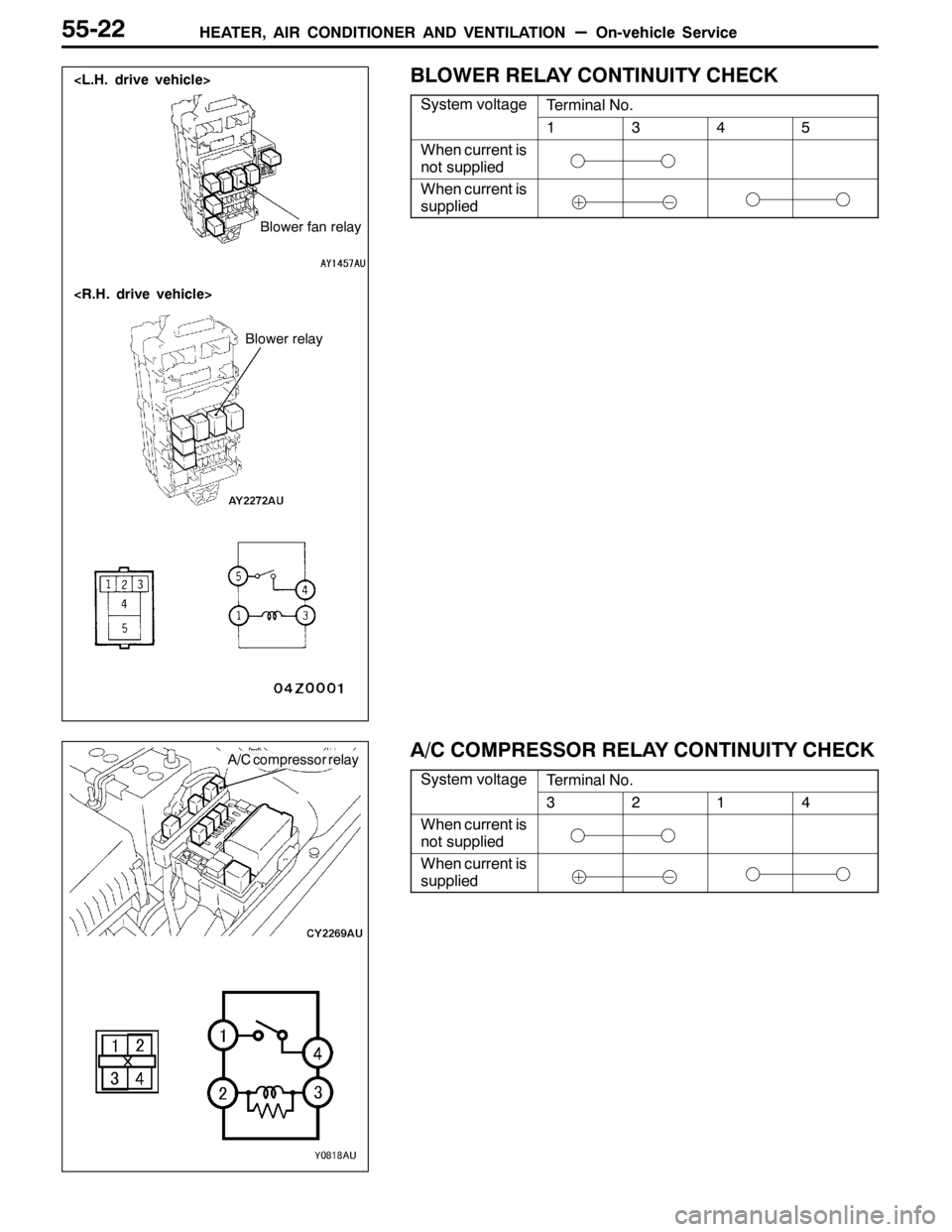
HEATER, AIR CONDITIONER AND VENTILATION–On-vehicle Service55-22
BLOWER RELAY CONTINUITY CHECK
System voltageTerminal No.yg
1345
When current is
not supplied
When current is
supplied
A/C COMPRESSOR RELAY CONTINUITY CHECK
System voltageTerminal No.yg
3214
When current is
not supplied
When current is
supplied
Blower fan relay
Blower relay
A/C compressor relay
Page 1425 of 1449
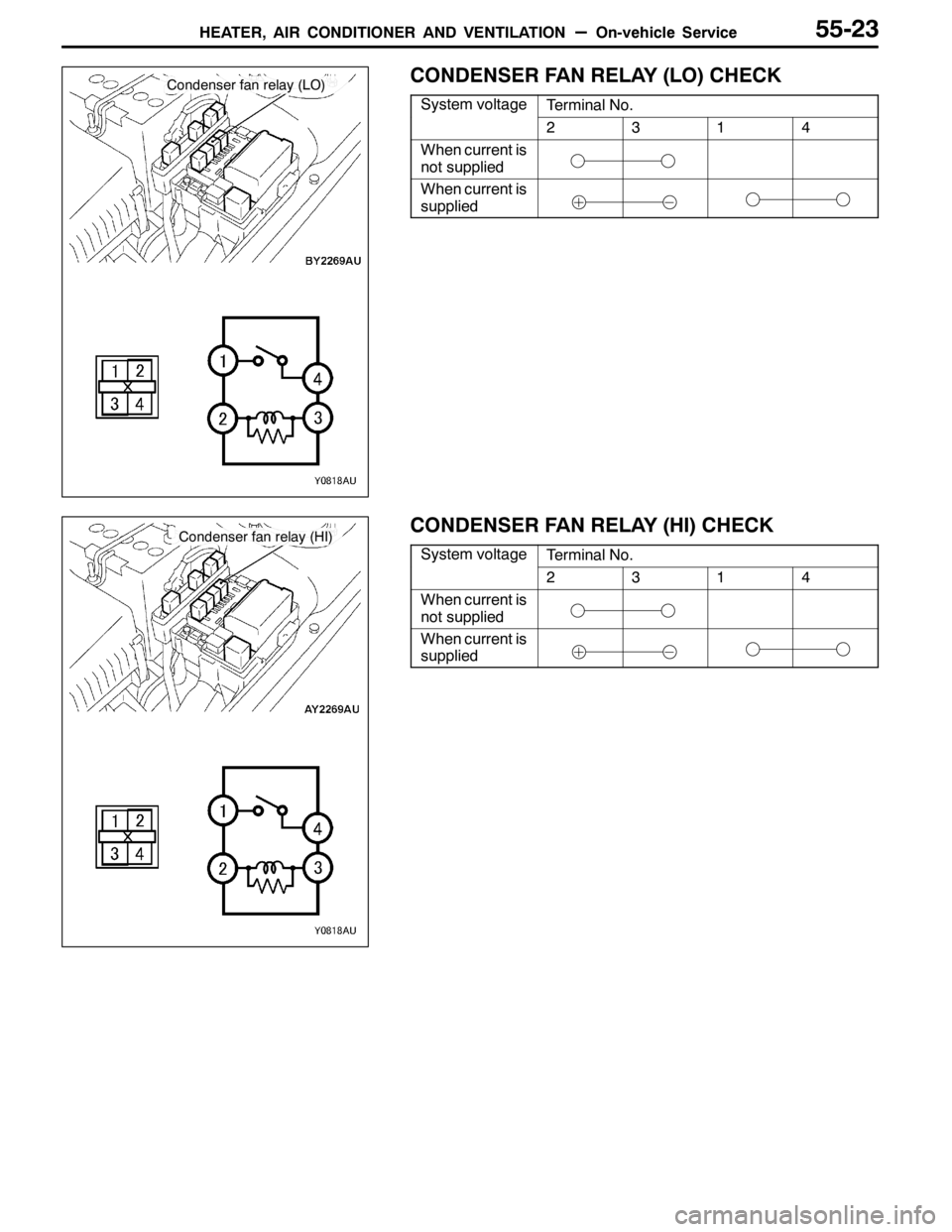
HEATER, AIR CONDITIONER AND VENTILATION–On-vehicle Service55-23
CONDENSER FAN RELAY (LO) CHECK
System voltageTerminal No.yg
2314
When current is
not supplied
When current is
supplied
CONDENSER FAN RELAY (HI) CHECK
System voltageTerminal No.yg
2314
When current is
not supplied
When current is
supplied
Condenser fan relay (LO)
Condenser fan relay (HI)
Page 1426 of 1449

HEATER, AIR CONDITIONER AND VENTILATION–On-vehicle Service55-24
IDLE-UP OPERATION CHECK
1. Set the vehicle in the pre-inspection condition:
Engine coolant temperature: 80 – 90_C
Lamps, electric cooling fan and all accessories: OFF
2. Check that the idle speed is within the standard value.
Standard value: 850±50 r/min
NOTE
The idle speed is controlled by the ISC system and should
not be adjusted.
3. The idle speed should be within the standard value when
the A/C switch is turned on and the A/C is operating.
Standard value:
850±50 r/min
Page 1427 of 1449
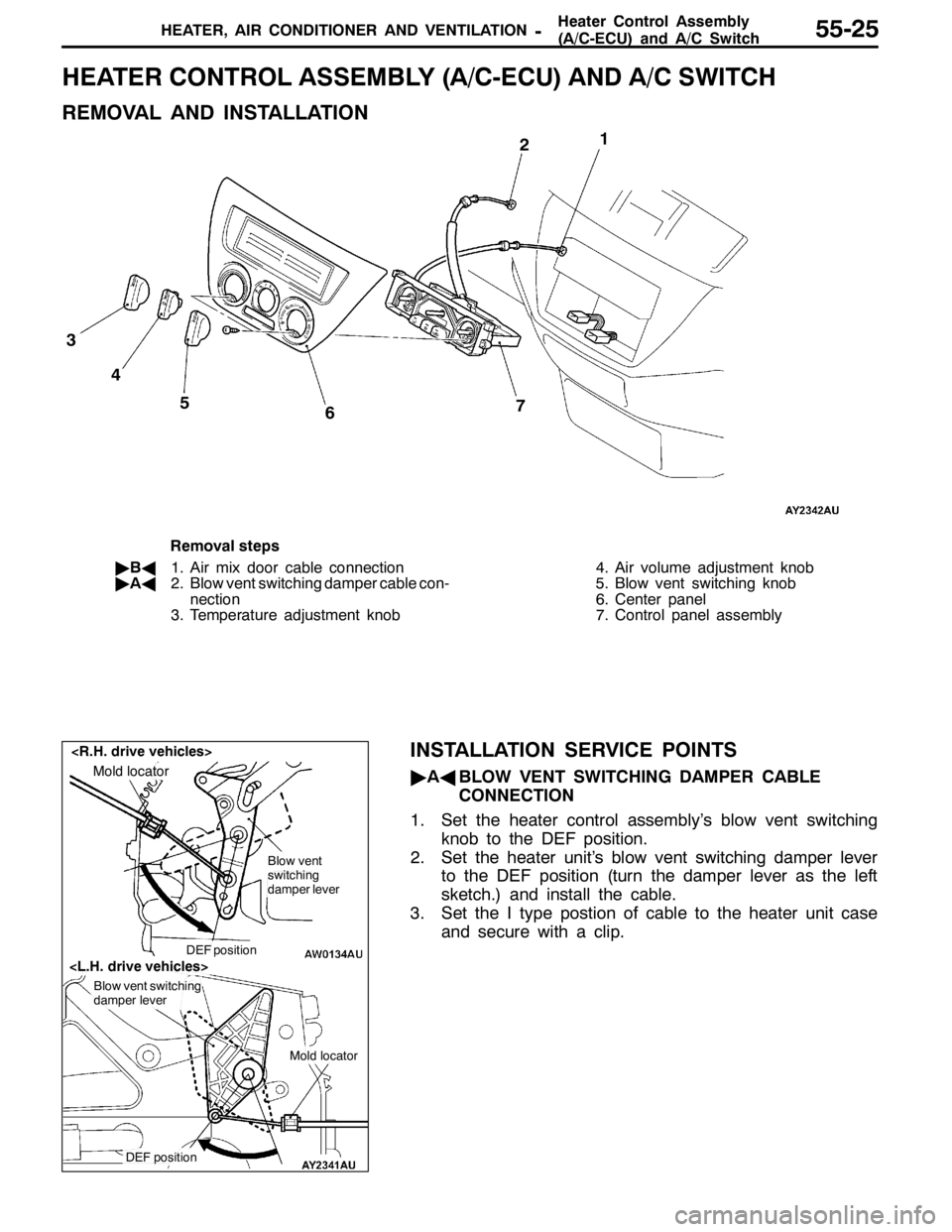
HeaterControlAssembly
(A/C-ECU) and A/C Switch HEATER, AIR CONDITIONER AND VENTILATION-55-25
HEATER CONTROL ASSEMBLY (A/C-ECU) AND A/C SWITCH
REMOVAL AND INSTALLATION
1
2
5
67 4
3
Removal steps
"BA1. Air mix door cable connection
"AA2. Blow vent switching damper cable con-
nection
3. Temperature adjustment knob4. Air volume adjustment knob
5. Blow vent switching knob
6. Center panel
7. Control panel assembly
INSTALLATION SERVICE POINTS
"AABLOW VENT SWITCHING DAMPER CABLE
CONNECTION
1. Set the heater control assembly’s blow vent switching
knob to the DEF position.
2. Set the heater unit’s blow vent switching damper lever
to the DEF position (turn the damper lever as the left
sketch.) and install the cable.
3. Set the I type postion of cable to the heater unit case
and secure with a clip.Mold locator
Blow vent
switching
damper lever
DEF position
Blow vent switching
damper lever
Mold locator
DEF position
Page 1428 of 1449
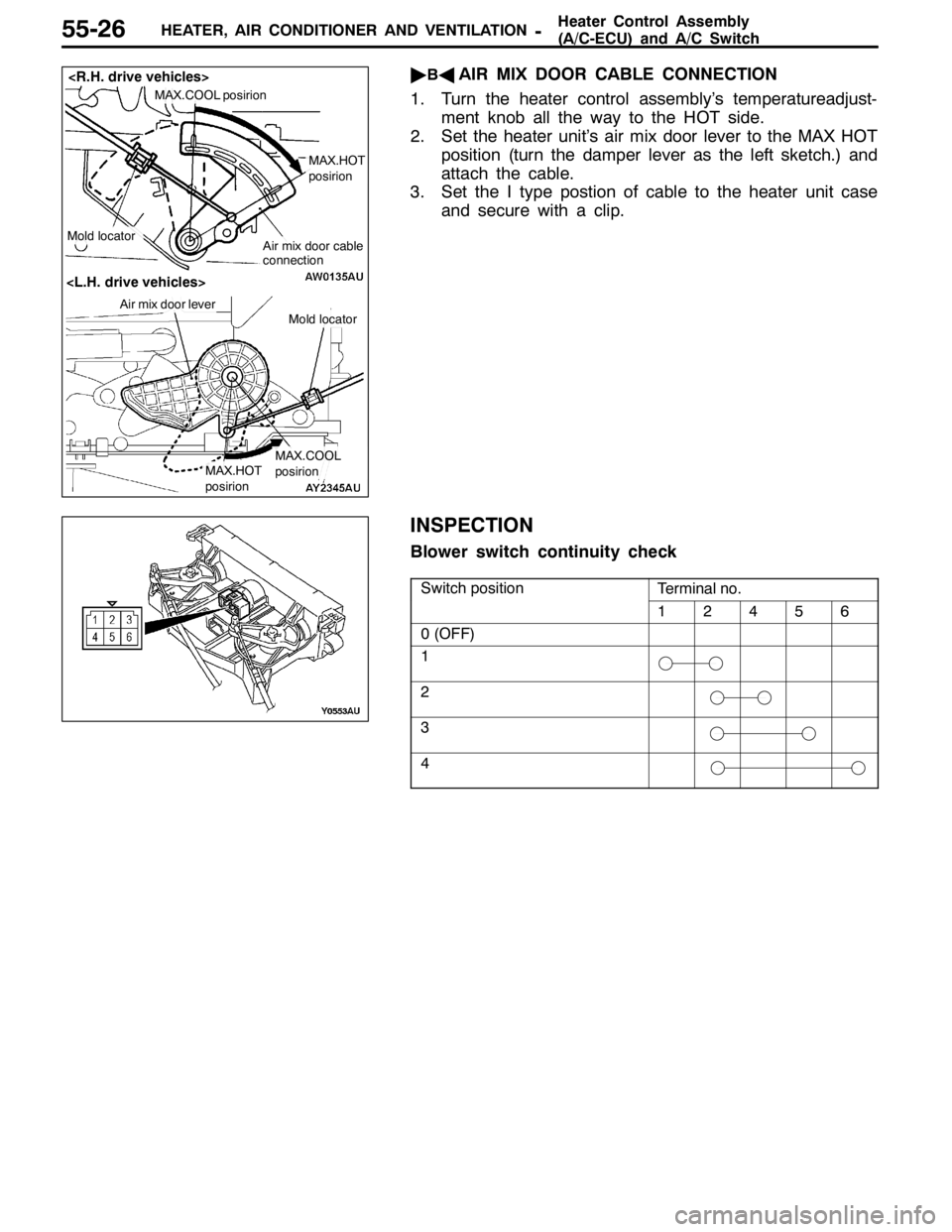
HeaterControlAssembly
(A/C-ECU) and A/C Switch HEATER, AIR CONDITIONER AND VENTILATION-55-26
"BAAIR MIX DOOR CABLE CONNECTION
1. Turn the heater control assembly’s temperatureadjust-
ment knob all the way to the HOT side.
2. Set the heater unit’s air mix door lever to the MAX HOT
position (turn the damper lever as the left sketch.) and
attach the cable.
3. Set the I type postion of cable to the heater unit case
and secure with a clip.
INSPECTION
Blower switch continuity check
Switch positionTerminal no.p
12456
0 (OFF)
1
2
3
4
MAX.HOT
posirion
MAX.HOT
posirion
Air mix door cable
connection
MAX.COOL posirion
Air mix door lever
MAX.COOL
posirion
Mold locator
Mold locator
Page 1429 of 1449

HeaterControlAssembly
(A/C-ECU) and A/C Switch HEATER, AIR CONDITIONER AND VENTILATION-55-27
DISASSEMBLY AND REASSEMBLY
1 2
5 67 8 3
4
Disassembly steps
1. Switch panel
2. Rear window defogger switch
3. Air conditioner switch
4. Inside/outside air changeover switch
AA"5. Blow vent changeover damper cableAA"6. Air mix damper cable
7. Blower switch assembly
8. Manual air conditioner control panel
(A/C-ECU)
ASSEMBLY SERVICE POINTS
AA"BLOW VENT CHANGEOVER DAMPER CABLE
AND AIR MIX DAMPER CABLE REMOVAL
Insert a flat-tipped screwdriver into the clip through the inside
of the control base and prise out the clip claw to disconnect
the cables.
Clip
claw
(–) flat-tipped
screwdriver
Page 1430 of 1449
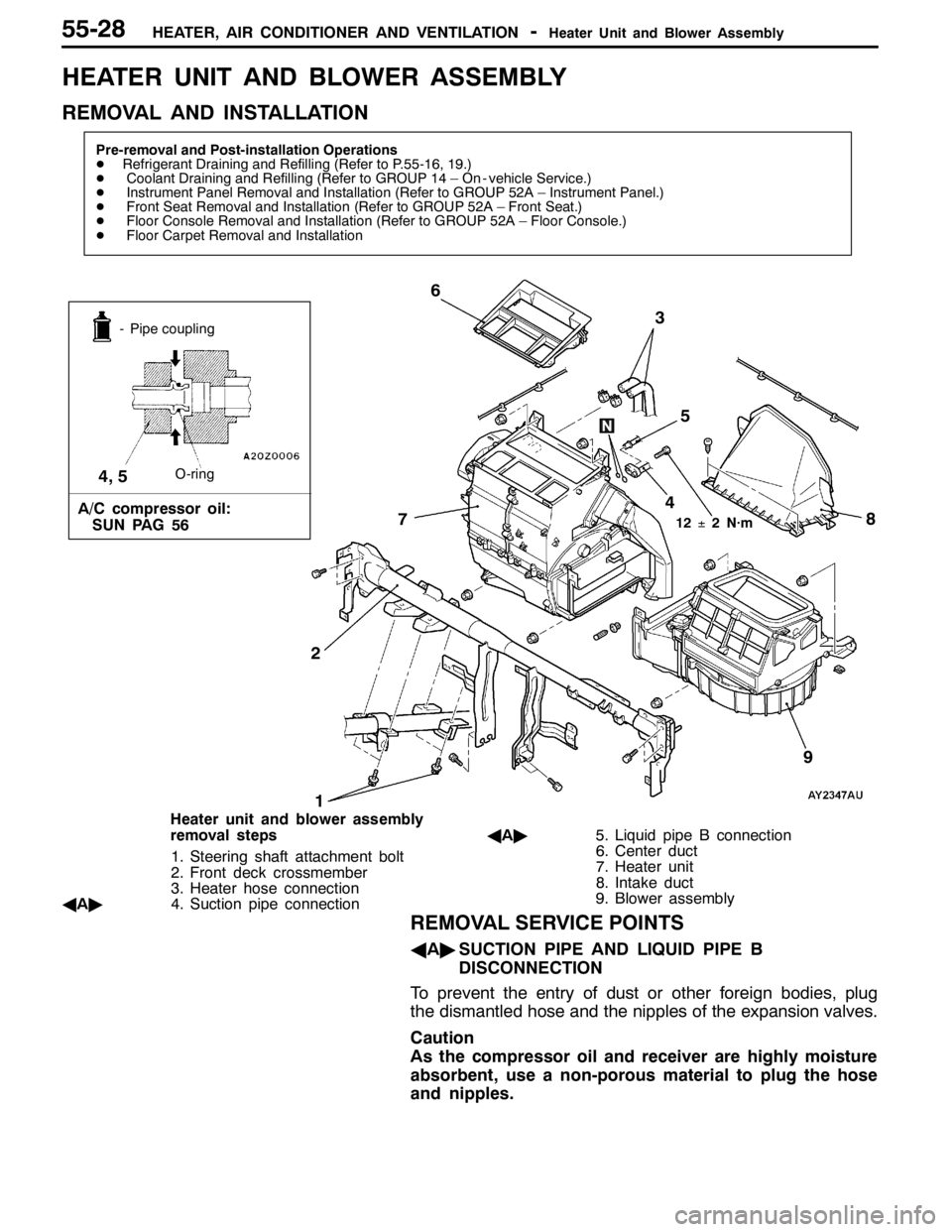
HEATER, AIR CONDITIONER AND VENTILATION-Heater Unit and Blower Assembly55-28
HEATER UNIT AND BLOWER ASSEMBLY
REMOVAL AND INSTALLATION
Pre-removal and Post-installation Operations
DRefrigerant Draining and Refilling (Refer to P.55-16, 19.)
DCoolant Draining and Refilling (Refer to GROUP 14 – On - vehicle Service.)
DInstrument Panel Removal and Installation (Refer to GROUP 52A – Instrument Panel.)
DFront Seat Removal and Installation (Refer to GROUP 52A – Front Seat.)
DFloor Console Removal and Installation (Refer to GROUP 52A – Floor Console.)
DFloor Carpet Removal and Installation
13
5 6
2
12±2 N·m
- Pipe coupling
O-ring
A/C compressor oil:
SUN PAG 56
4, 5
9
7
4
8
Heater unit and blower assembly
removal steps
1. Steering shaft attachment bolt
2. Front deck crossmember
3. Heater hose connection
AA"4. Suction pipe connectionAA"5. Liquid pipe B connection
6. Center duct
7. Heater unit
8. Intake duct
9. Blower assembly
REMOVAL SERVICE POINTS
AA"SUCTION PIPE AND LIQUID PIPE B
DISCONNECTION
To prevent the entry of dust or other foreign bodies, plug
the dismantled hose and the nipples of the expansion valves.
Caution
As the compressor oil and receiver are highly moisture
absorbent, use a non-porous material to plug the hose
and nipples.